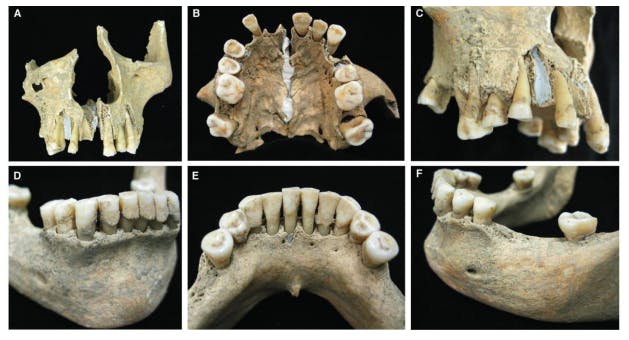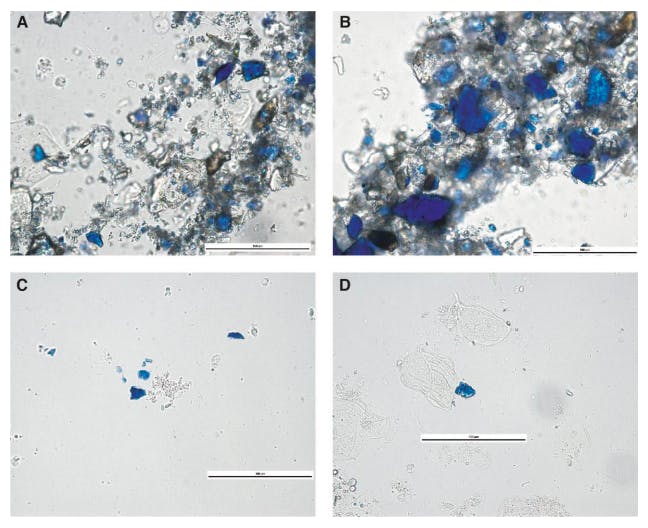When an academic makes a research breakthrough, two things can happen in the public consciousness: nothing, or something. It’s hard to know which is worse. Let’s say you’re a physicist who discovers a particle that isn’t affected by gravity. If nobody outside the physics world cares about your discovery, you sigh, shake your head, get back to the lab. If your story does hit the newspapers, on the other hand, you’ll have to adjust to a different kind of outrage: Your scrupulous research will be repurposed into some bad headline (“GRAVITY DISPROVEN”) designed to yank eyeballs, extract clicks, and generally trample over your precious academic principles.
Last week, the second thing happened. In a new article for Science Advances, Anita Radini, an archaeologist at Britain’s University of York, published evidence showing the presence of lapis lazuli—an ancient, rare, lovely blue stone pigment—on the teeth of a medieval German nun. The nun’s skeleton, named “B78,” dates from the 11th or early 12th century and was found in an unmarked grave in the German town of Dalheim. By working with tartar experts, microscopists, and medieval historians, Radini was able to conclude that this woman must have been a painter or scribe (or both) who illuminated manuscripts.

She must also have been a very good one, since lapis lazuli was an extremely expensive pigment only mined in Afghanistan. It was reserved for the hands of high-end professionals. The pigment probably got into her mouth directly from the paintbrush, over the course of many years of work.
The story is delightful, all by itself. There’s an element of chance to the findings—nobody was looking for lapis lazuli on these teeth—which lends them the charm of serendipity. The confluence of beautiful medieval art and chemistry has a poetry all of its own.
But it was not quite enough for the media. Several reporters ran with the angle that this evidence countered a longstanding assumption that manuscripts were only ever painted by men. “And so these embedded blue particles in her teeth illuminate a forgotten history of medieval manuscripts,” Sarah Zhang wrote at The Atlantic. “Not just monks made them.” In The New York Times, reporter Steph Yin bolstered that narrative with this quote from the medievalist Alison Beach, who is listed as one of the paper’s co-authors:
The finding upends the conventional assumption that medieval European women were not much involved in producing religious texts. “Picture someone copying a medieval book—if you picture anything, you’re going to picture a monk, not a nun,” said Alison Beach, a historian at Ohio State University, and an author on the study.
But any medievalist worth her salt already knows that women made manuscripts, too. Beach here is referring to a stereotype, not to a lack of awareness—she’s published work for decades proving the existence of female scribes in this particular historical era. (Look up her 2000 paper “Claustration and Collaboration between the Sexes in the Twelfth-Century Scriptorium,” if you’re curious.)
The Times didn’t misrepresent Beach’s words, exactly. It mined them for the most relatable tidbit, the most pertinent comment. But medieval historians can be quite a shirty bunch, and a brouhaha over the quotation erupted on social media.

“I share in excitement about recent lapis lazuli discovery,” Elizabeth Lehfeldt, professor of history at Cleveland State University, tweeted. “But here’s the thing: it *adds* to the existing scholarship by @AlisonIBeach and others. We haven’t ‘discovered’ that medieval women were artists. We already knew that.” Beach herself tweeted, “Amazing the degree to which [reporters] chop up what you say and reframe without ur caveats and explanations!”
Complicated arguments followed about epistemological hierarchies and rhetoric and medieval scriptoria. But the central critique was that this splashy announcement, tethered to some surprising German teeth, ended up obscuring, rather than illuminating, the long and lonely labors of medievalists.
I’ve written elsewhere about what happens in their little corner of the internet. The field contains a lot of intriguing mysteries, which leads to a lot of amateur speculation. For example, there are plenty of Redditors and the like who enjoy debating the identity of the unknown author of the Voynich Manuscript. Every now and again, some theorist will come up with a new idea; then, swift as can be, some professional medievalist will point out the glaring flaws in their evidence.
Inevitably, discussion will ensue about the sad marginalization of medieval studies in the contemporary humanities, and the way “medieval” is still bandied around as some kind of marker of barbarism. But the case of the nun with the blue teeth is a much more interesting controversy, because it stems from many-layered assumptions—both historical and contemporary—around gender and labor. Journalists assumed that women didn’t make manuscripts. Moreover, they assumed that this assumption was widespread even in the field of medieval studies.
Beach has been generous about the Times piece, and all those excited by nun-teeth-gate; “rather than lament that people didn’t know about my work of 25 years,” she tweeted, “I am celebrating that this [evidence] got the attention it did.” Furthermore, Beach tweeted, “knowing that women copied books and [...] shifting the a priori assumptions of our own broader academic field are two different matters.” Just because informed academic circles were aware that this German nun wasn’t an outlier, doesn’t mean that prejudice against women’s roles in history doesn’t perpetuate itself, even within academia. “I still struggle to get some colleagues to consider female production and provenance,” Beach wrote.
And so the surprising story of some blue-flecked teeth has taken on an odd new life. Despite the apparent neutrality of the paper’s information—chemical analysis reveals presence of blue stone in medieval tartar—its contents instantly became a battleground. The German nun herself seemed to fade away, ceding importance to the reporters and chemists and medievalists and other medievalists who all claim the revelation to be their own, or to be theirs to interpret correctly.
Like the grubby old tooth itself, which under the microscope turned out to be the bearer of brilliant and complicated information, the debacle of the nun’s teeth shows us that all knowledge remains negotiable, contested. Among many, the chief lesson of the nun’s teeth must be that women and their work still matter, a lot, to people today. Archaeology has restored one woman’s resumé. It’s a little late, of course, but better than never.